
Linear Regression
MATH/COSC 3570 Introduction to Data Science
Department of Mathematical and Statistical Sciences
Marquette University
What is Regression
Regression models the relationship between a numerical response variable \((Y)\) and one or more numerical/categorical predictors \((X)\), which is a supervised learning method in machine learning.
A regression function \(f(X)\) describes how a response variable \(Y\) generally changes as an explanatory variable \(X\) changes.
Examples:
college GPA \((Y)\) vs. ACT/SAT score \((X)\)
sales \((Y)\) vs. advertising expenditure \((X)\)
crime rate \((Y)\) vs. median income level \((X)\)
Simple Linear Regression
\[\begin{align*} y_i &= f(x_i) + \epsilon_i \\ &= \beta_0 + \beta_1~x_{i} + \epsilon_i, \quad i = 1, 2, \dots, n \end{align*}\]
- \(\beta_0\) and \(\beta_1\) are unknown parameters to be learned or estimated.

What are the assumption on \(\epsilon_i\)?
\(\epsilon_i \sim N(0, \sigma^2)\) and hence \(y_i \mid x_i \sim N(\beta_0+\beta_1x_i, \sigma^2)\)
Simple Linear Regression Assumptions
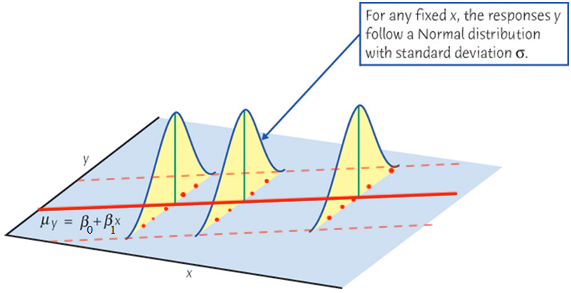
Simple Linear Regression Assumptions
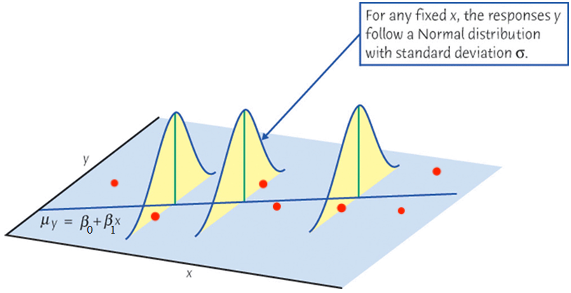
Simple Linear Regression Assumptions
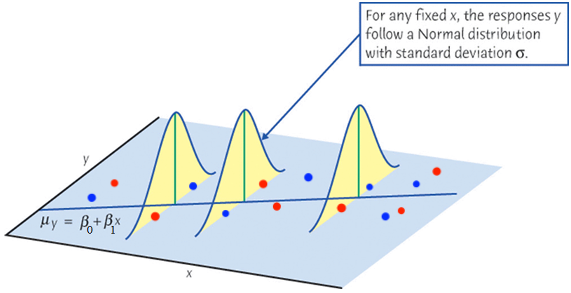
Ordinary Least Squares (OLS)
Given the training data \((x_1, y_1), \dots, (x_n, y_n)\), use sample statistics \(b_0\) and \(b_1\) computed from the data to
inference: estimate \(\beta_0\) and \(\beta_1\)
fitting: estimate \(y_i\) or \(f(x_i)\) at \(x_i\) by its fitted value \[\hat{y}_{i} = \hat{f}(x_i) = b_0 + b_1~x_{i}\]
prediction: predict \(y_j\) or \(f(x_j)\) at \(x_j\) by its predicted value \[\hat{y}_{j} = \hat{f}(x_j) = b_0 + b_1~x_{j}\] where \((x_j, y_j)\) is never seen and used in training before.
- Ordinary Least Squares: Find \(b_0\) and \(b_1\), or regression line \(b_0 + b_1x\) that minimizes the sum of squared residuals.
- The residual \(e_i = y_i - \hat{y}_i\). The sample regression line minimizes \(\sum_{i = 1}^n e_i^2\).
Visualizing Residuals
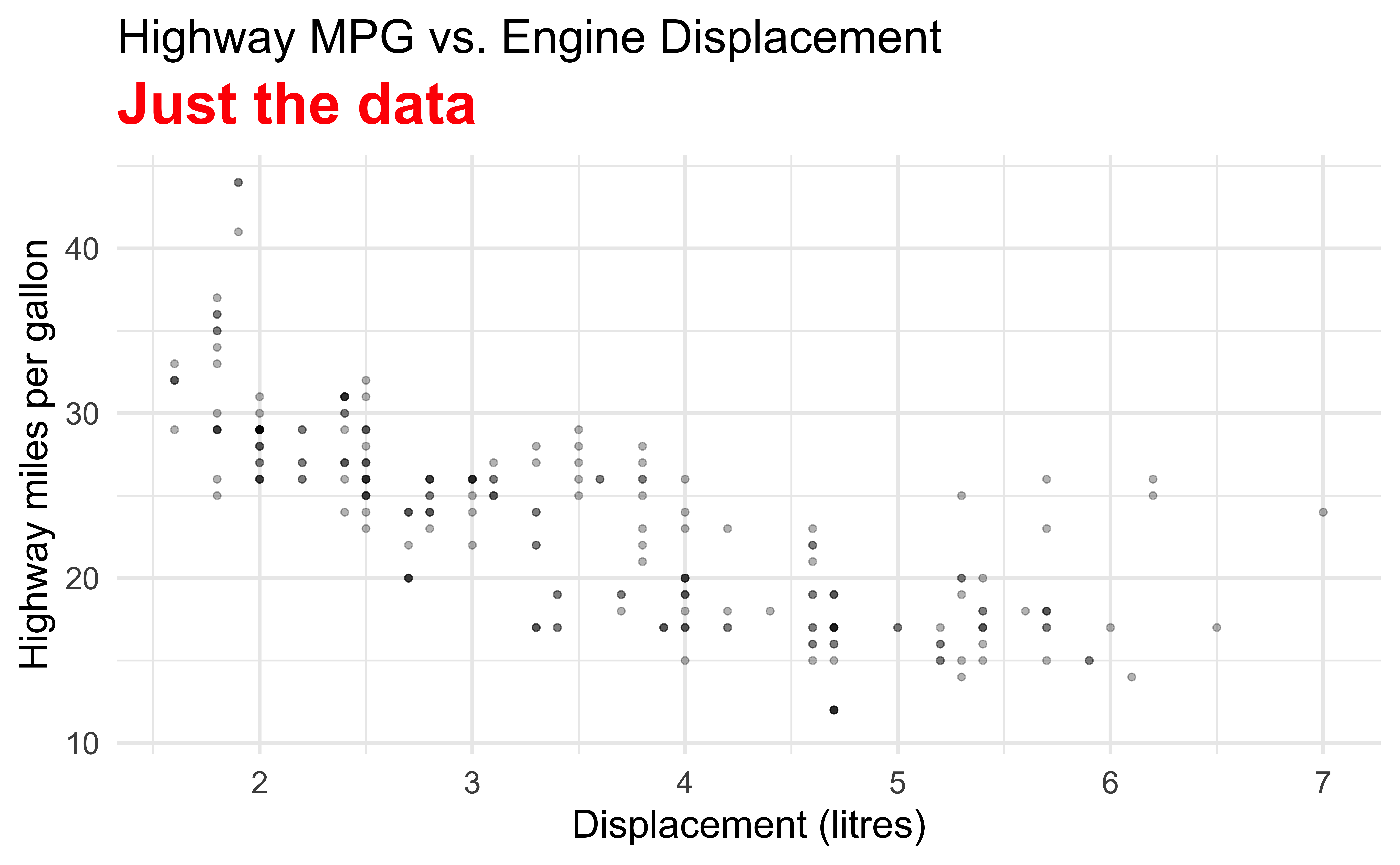
Visualizing Residuals (cont.)
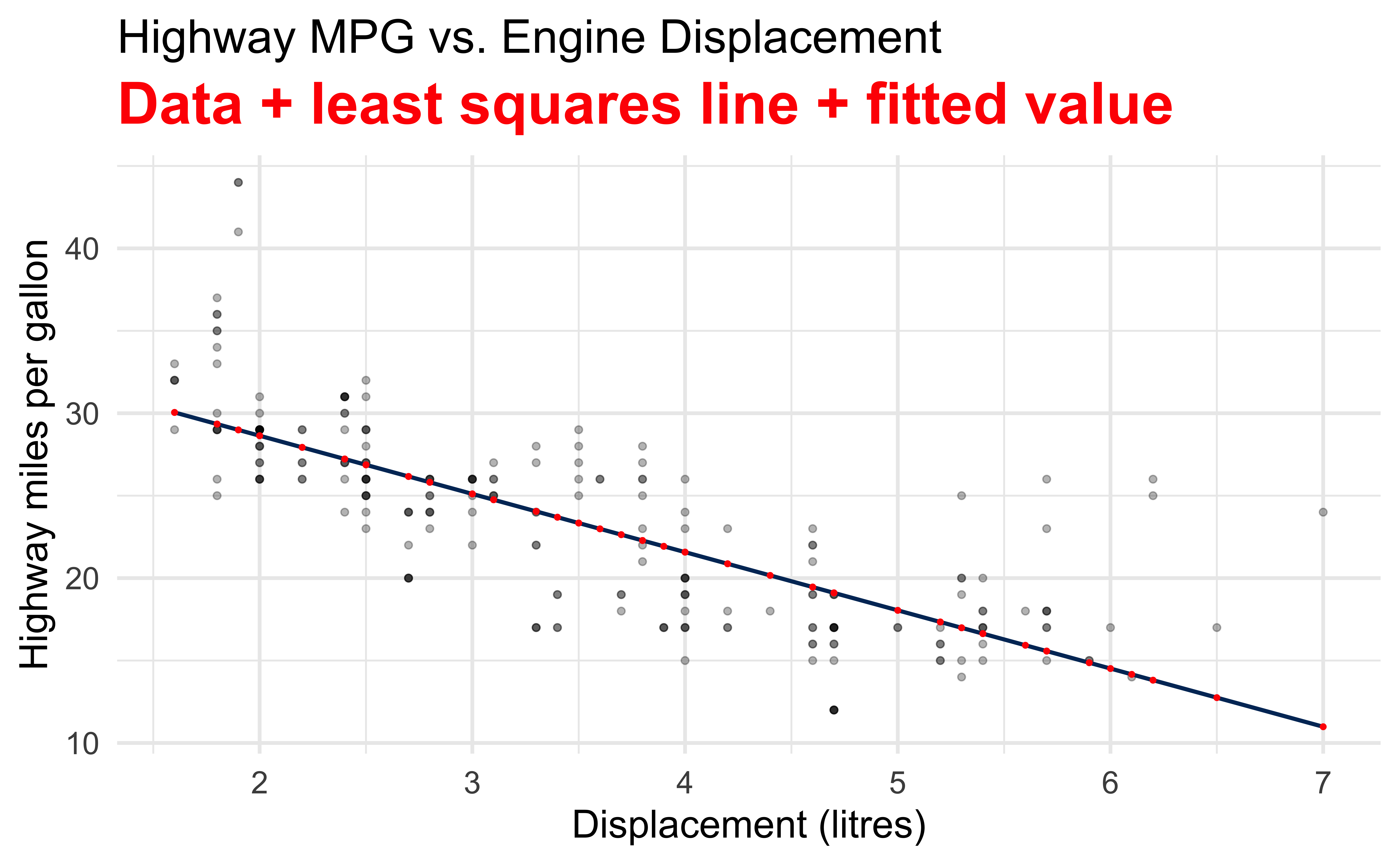
Visualizing Residuals (cont.)
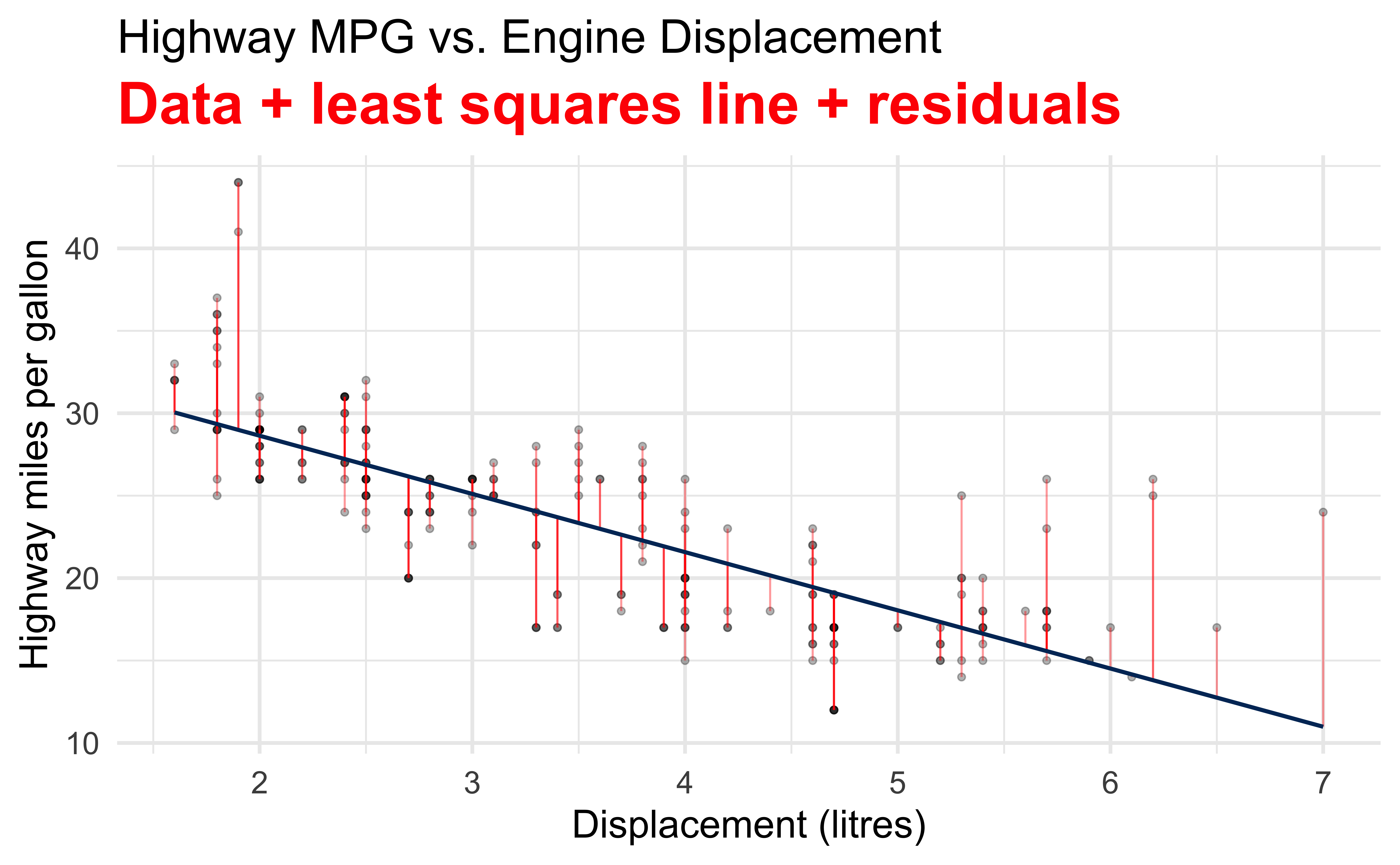
Fitting and Interpreting Regression Models
Predict Highway MPG hwy from Displacement displ
\[\widehat{hwy}_{i} = b_0 + b_1 \times displ_{i}\]
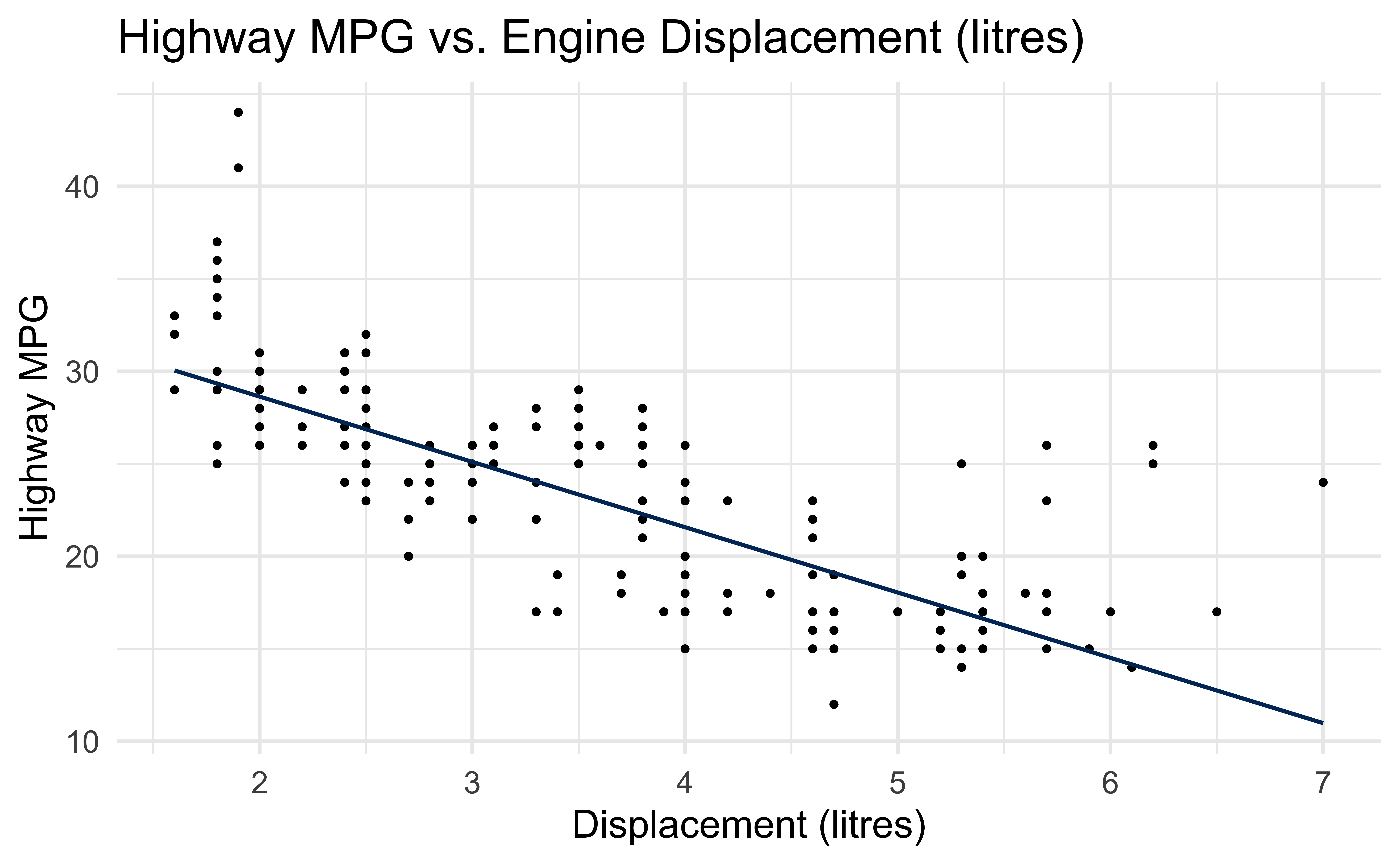
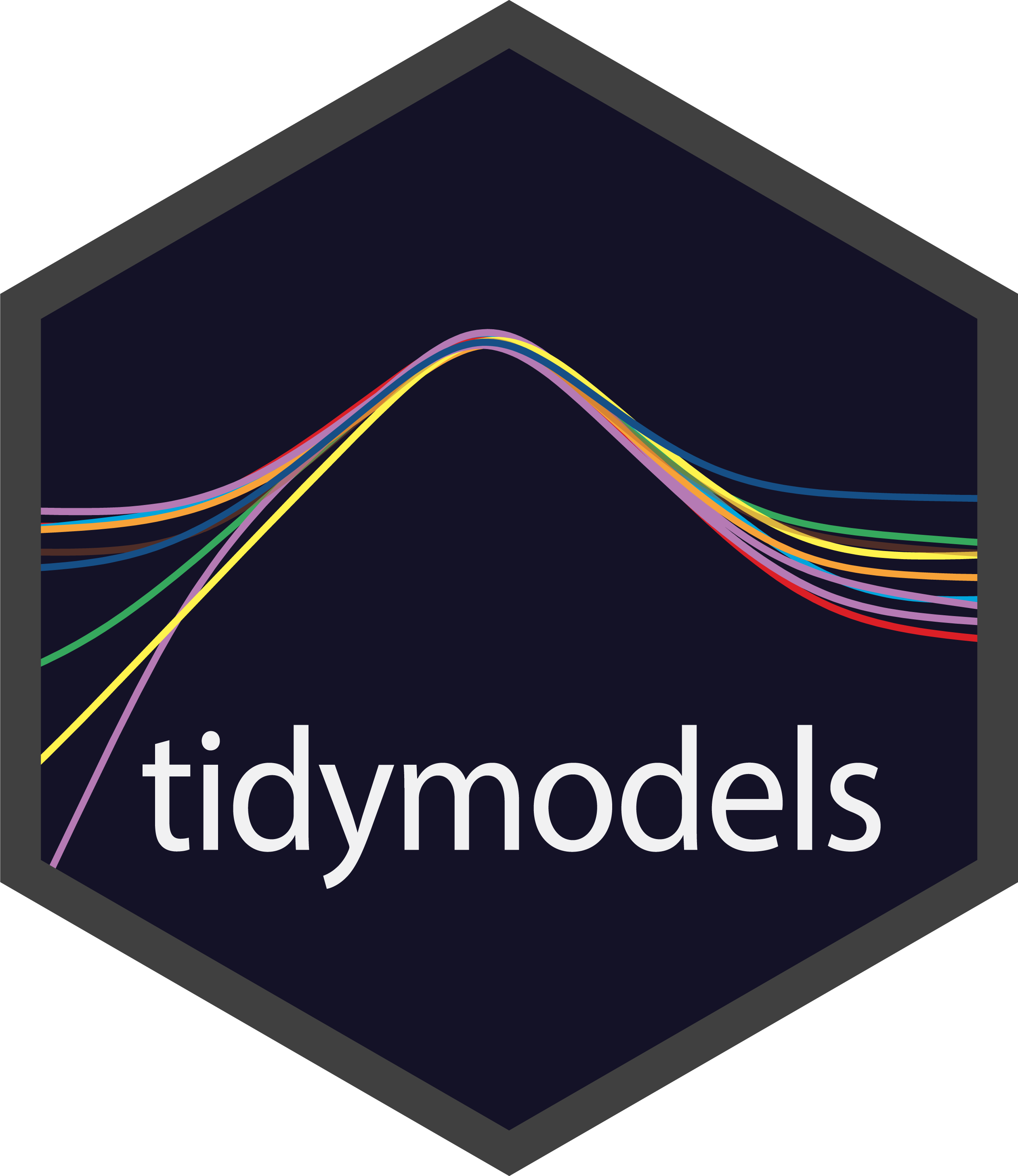





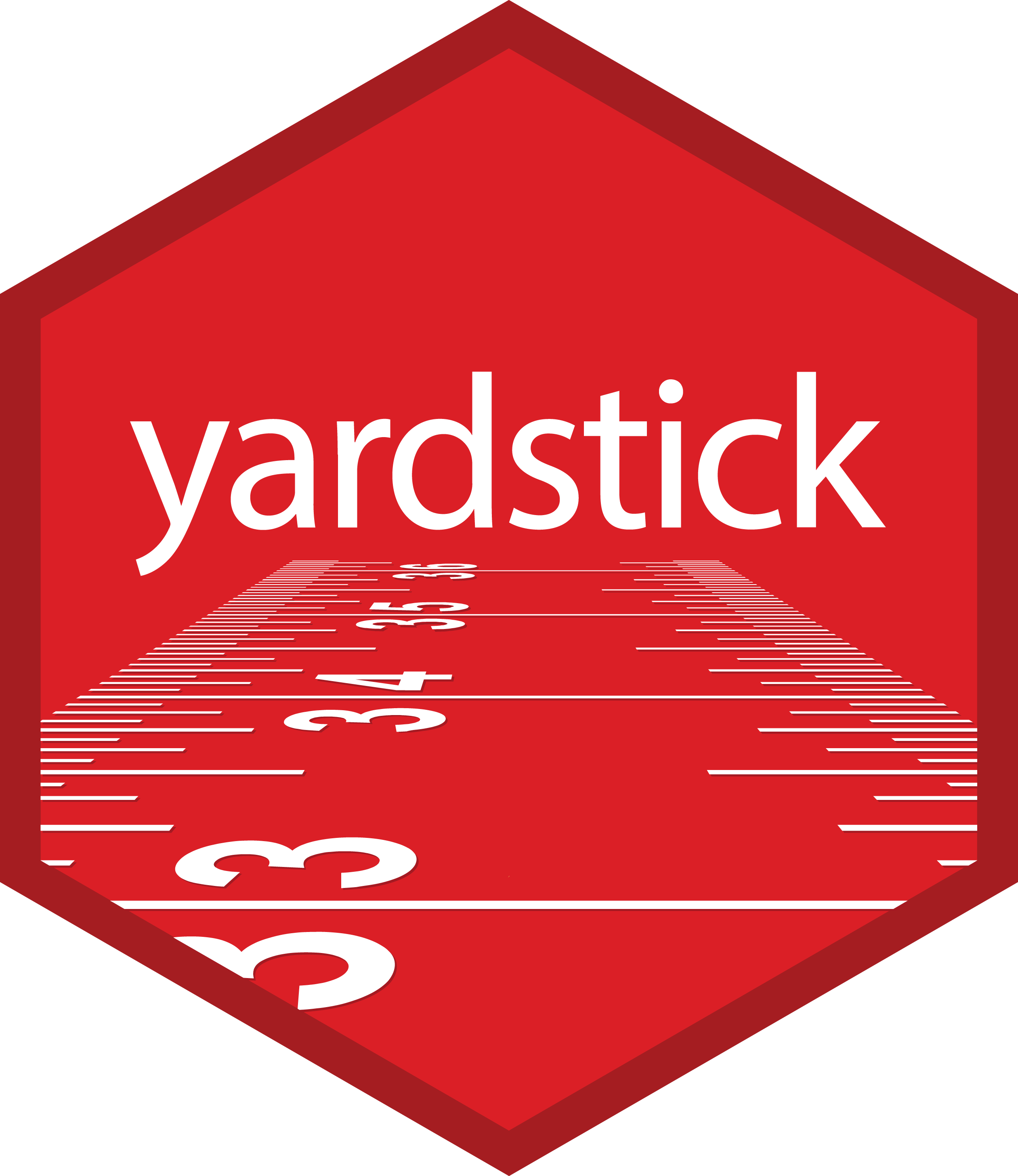


Tidymodels
Step 1: Specify Model: linear_reg()
Linear Regression Model Specification (regression)
Computational engine: lm parsnip package provides a tidy, unified interface for fitting models

Step 2: Set Model Fitting Engine
- By default, use
lm()in the built-in stats package.
Linear Regression Model Specification (regression)
Computational engine: lm Step 3: Fit Model & Estimate Parameters
… using formula syntax
parsnip model object
Call:
stats::lm(formula = hwy ~ displ, data = data)
Coefficients:
(Intercept) displ
35.70 -3.53 \[\widehat{hwy}_{i} = 35.7 -3.53 \times displ_{i}\]
- Slope: When the engine displacement volume of a car is increased by one litre, the highway miles per gallon is expected to be lower, on average, by 3.53 miles.
Tidy Look at Model Output
- Tidymodels output (tibble)
# A tibble: 2 × 5
term estimate std.error statistic p.value
<chr> <dbl> <dbl> <dbl> <dbl>
1 (Intercept) 35.7 0.720 49.6 2.12e-125
2 displ -3.53 0.195 -18.2 2.04e- 46\[\widehat{hwy}_{i} = 35.7 -3.53 \times displ_{i}\]
Quantify Uncertainty about Coefficients
- Uncertainty about regression coefficients \(\beta_0\) and \(\beta_1\)
Quantify Uncertainty about Mean of \(y\)
- Uncertainty about the mean value of \(y\) given \(X = x\) \[\mu_{Y \mid X = x} = \beta_0 + \beta_1x\]
Quantify Uncertainty about Mean of \(y\)

p <- ggplot(data = reg_out_fit,
aes(x = displ, y = hwy)) +
geom_point(alpha = 0.3) +
labs(title = "Highway MPG vs. Engine Displacement",
x = "Displacement (litres)",
y = "Highway miles per gallon") +
coord_cartesian(ylim = c(11, 44))
p_ci <- p + geom_smooth(method = "lm",
color = "#003366",
fill = "blue",
se = TRUE)Quantify Uncertainty about Individual \(y\)
- Uncertainty about the individual value of \(y\) given \(X = x\), \(Y \mid X = x\)
fit lwr upr
1 25.1 17.53 32.7
2 21.6 14.00 29.2
3 18.0 10.45 25.6
4 14.5 6.88 22.1 fit lwr upr
1 29.3 21.7 36.9
2 29.3 21.7 36.9
3 28.6 21.0 36.2
4 28.6 21.0 36.2
5 25.8 18.2 33.4
6 25.8 18.2 33.4Quantify Uncertainty about Individual \(y\)

Model Checking
Graphical Diagnostics: Residual Plot
- Residuals distributed randomly around 0.
- Check it by plotting residuals against the fitted value of \(y\): \(e_i\) vs. \(\hat{y}_i\)
- With no visible pattern along the x or y axis.

Not looking for…
Fan shapes

Not looking for…
Groups of patterns

Not looking for…
Residuals correlated with predicted values

Not looking for…
Any patterns!

MPG Data Residuals

Models with Categorical Predictors
Categorical Predictor with 2 Categories
-
trans = auto: Automatic transmission -
trans = manual: Manual transmission
Highway MPG & Transmission Type
- Make sure that your categorical variable is of type character or factor.
# A tibble: 2 × 5
term estimate std.error statistic p.value
<chr> <dbl> <dbl> <dbl> <dbl>
1 (Intercept) 22.3 0.458 48.7 8.60e-124
2 transmanual 3.49 0.798 4.37 1.89e- 5- The baseline level is chosen to be
autotransmission.
Highway MPG & Transmission Type
# A tibble: 2 × 5
term estimate std.error statistic p.value
<chr> <dbl> <dbl> <dbl> <dbl>
1 (Intercept) 22.3 0.458 48.7 8.60e-124
2 transmanual 3.49 0.798 4.37 1.89e- 5\[\widehat{hwy_{i}} = 22.3 + 3.49~trans_i\]
-
Slope: Cars with manual transmission are expected, on average, to be 3.49 more miles per gallon than cars with auto transmission.
- Compare baseline level (
trans = auto) to the other level (trans = manual)
- Compare baseline level (
- Intercept: Cars with auto transmission are expected, on average, to have 22.3 highway miles per gallon.
sklearn.linear_model.LinearRegression
sklearn.linear_model.LinearRegression
sklearn.linear_model.LinearRegression
array([25.10588463, 21.57529583, 18.04470702, 14.51411821])